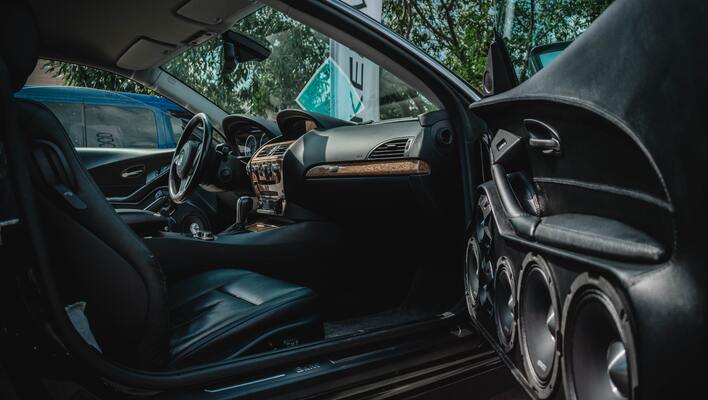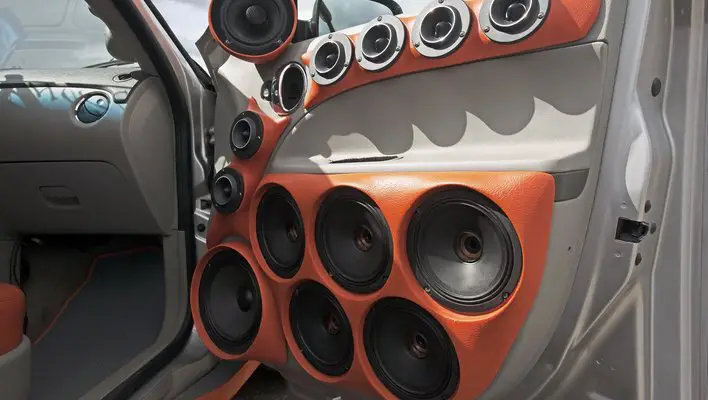Are you a car audio enthusiast? Do you want to build or upgrade your existing sound system and wonder what size subwoofer I need for my car? You have come to the right place.
If you are just starting out with car audio, it can be a bit overwhelming when you see all the different systems and options at your disposal. You may ask yourself, how much power do I need for my system? Or what size subwoofer do I need for my car?
Many products available in the market can look great in your car but might not be the right thing. If you are going to install a sub, install it as per the size and design of your car.
Subwoofers are among the essential components of your car’s audio system. For this reason, it is recommended you choose carefully. For starters, there are five main subwoofers: sealed, vented, band pass, passive radiator, and active subwoofer. All these subs come in various sizes and shapes.
So, how can you choose the right one with so many subwoofers out there? You don’t want to get ripped off or buy a sub that doesn’t fit your need. Below, we show you how to choose the right size subwoofer without breaking a sweat.

What Subwoofer Fits my Car?
The first step in buying a subwoofer is to find out what size subwoofer fits your car. You can get away with a 10-inch subwoofer if you have a hatchback. However, you will need something more significant if you have an SUV or a sedan.
There are two main types of subs: sealed and ported. Sealed subs are smaller and more compact than ported ones but don’t produce as much bass as their ported counterparts.
Ported subs are larger and heavier but produce more bass than sealed ones. You’ll need to decide which type of subwoofer is right for your vehicle before you start shopping.
What size subwoofer do I need for my car?
The most common way to measure a subwoofer is with its diameter, or how wide it is. A 12” subwoofer has a diameter of 12 inches, while a 10” subwoofer has a diameter of 10 inches.
The most common sizes are 10”, 12” and 15”, but there are smaller ones like the 6-inch subwoofers too.
1. 8 Inch Subwoofers
A typical size for an 8-inch subwoofer is two cubic feet. This means that the box will measure out at around 24 x 18 x 12 inches.
This makes it a little larger than other similarly sized subs, but it also has more room inside to move air around and make noise. You can find 8-inch subwoofers with various power ratings, ranging from 100 watts up to 600 watts or more.
2. 10 Inch Subwoofers
If you want a subwoofer that you can hear but not see, then a 10” would be a good choice. They’re small enough to fit under the seat or in the boot without too much trouble. They still produce decent bass. A 10-inch sub can go down to about 80 Hz or so.
3. 12 Inch Subwoofers
A 12” subwoofer is an excellent all-round size, with enough power to satisfy most people’s needs without being too big or heavy. A 12-inch sub will give you deeper bass, but it won’t be nearly as loud as an 8 or 10-inch model due to its limited excursion capabilities.
4. 15 Inch Subwoofers
A 15” subwoofer will give you the most powerful bass available, but they’re also quite large and heavy. These subs need a lot of space in your car’s boot or trunk to fit them properly.
Once you’ve figured out what size subwoofer fits your vehicle, it’s time to pick a brand and model that suits your needs and tastes.

How to Measure a Subwoofer Size
The driver’s diameter, length, and cone area determine subwoofer size. The diameter of a driver is the dimension of its front surface; for a subwoofer, this is usually in inches. The length of a driver is its overall length, which in most cases is measured from one mounting frame to the other.
There are several ways to measure your subwoofer’s dimensions:
Using a measuring tape.
This is one of the simplest ways to measure your subwoofer. Wrap the tape measure around the speaker cone at its widest point and write down that measurement. Additionally, measure the mounting depth, width, and mounting height.
Use a ruler or other straight edge.
If you don’t have a measuring tape handy, you can use any straight edge that is longer than the distance between two sides of your speaker cone. Measure from one end of the straight edge to another.
Using a protractor or compass and pencil or pen.
You can also use this method if you have access to a protractor, compass, pencils, or pens with ink that doesn’t smudge easily. Measure the cutout diameter in relation to the speaker diameter by drawing circles on two pieces of paper.
Some tips as you measure a car subwoofer size:
- Make sure you unload the subwoofer. Unload it by disconnecting the amp and other speakers.
- Measure the depth of the speaker enclosure.
- Measure the width of the speaker box as well as its height from top to bottom.
- Measure the diameter of the basket with a ruler or calipers.
- Measure the depth of the basket from edge to edge using a ruler or calipers.
Choosing the Right Subwoofer
To decide what size subwoofer you need, consider these factors:
1. The bass you want in your music
You will want a larger subwoofer if you want a deep, thumping sound. If you are looking for a higher-pitched sound, look for a smaller one. In general, the larger a subwoofer is, the deeper it will play and vice versa.
2. The space you have in your vehicle
You may consider buying a smaller subwoofer if you have limited space in your trunk or back seat area for an enclosure. It will take up less space and still produce enough bass to fill the listening area.
However, if you have plenty of space in your vehicle, go ahead and get that big 12” woofer everybody wants.
3. The type of music you enjoy
Additionally, determine what type of music you listen to most often and how loud it gets when played at high volumes. A good rule of thumb is that if you listen to hip hop, look for a 10-inch woofer, but if you lean more towards rock music, choose a 12-inch woofer instead.
4. Type of subwoofer
You need to know what type of subwoofer will best suit your needs.
There are two types of subwoofers: sealed and ported. Sealed subwoofers have smaller enclosures and produce less bass than ported ones. They are also less expensive than ported models.
Ported models offer more bass at low frequencies but require enclosures like sealed boxes to enhance their performance.
5. Power your subwoofer can handle
You need to consider how much power your subwoofer can handle before it burns out or gets damaged due to overheating. Subwoofers usually have different RMS power handling ratings depending on their size and design.
It’s important to choose a sub with an RMS rating that matches your amplifier’s capabilities so they don’t damage each other.

Car Subwoofer Size vs Room Size
The room size in your car has an enormous impact on how good your subwoofer will sound. Generally speaking, the larger the room, the more bass you want.
If you have a small room and want a decent bass response from your subwoofer, you should consider getting a larger one. However, if you try to fit your subwoofer into an already crowded trunk space or another tight area, you might be better off with a smaller sub.
In most cases, a 15-inch subwoofer will produce more bass than an 8-inch model because it can move more air and produce louder sounds.
If you are trying to fill a larger room of your car with bass, you will need a bigger subwoofer. If your goal is to increase clarity and definition in your listening experience, consider adding a second subwoofer instead of sheer volume.
Parting Word
We have endeavored to answer the question what size subwoofer do I need for my car? Choosing the right subwoofer for your system will significantly improve the stock unit and is one of the most important decisions you’ll need to make. A subwoofer essentially takes over the bass duties in your car, and it can make or break your listening experience.
Although buying a subwoofer is a personal and subjective decision, our advice and research will hopefully help get you on the right track. There’s certainly no shortage of choices out there, but hopefully, we’ve helped narrow the search.

